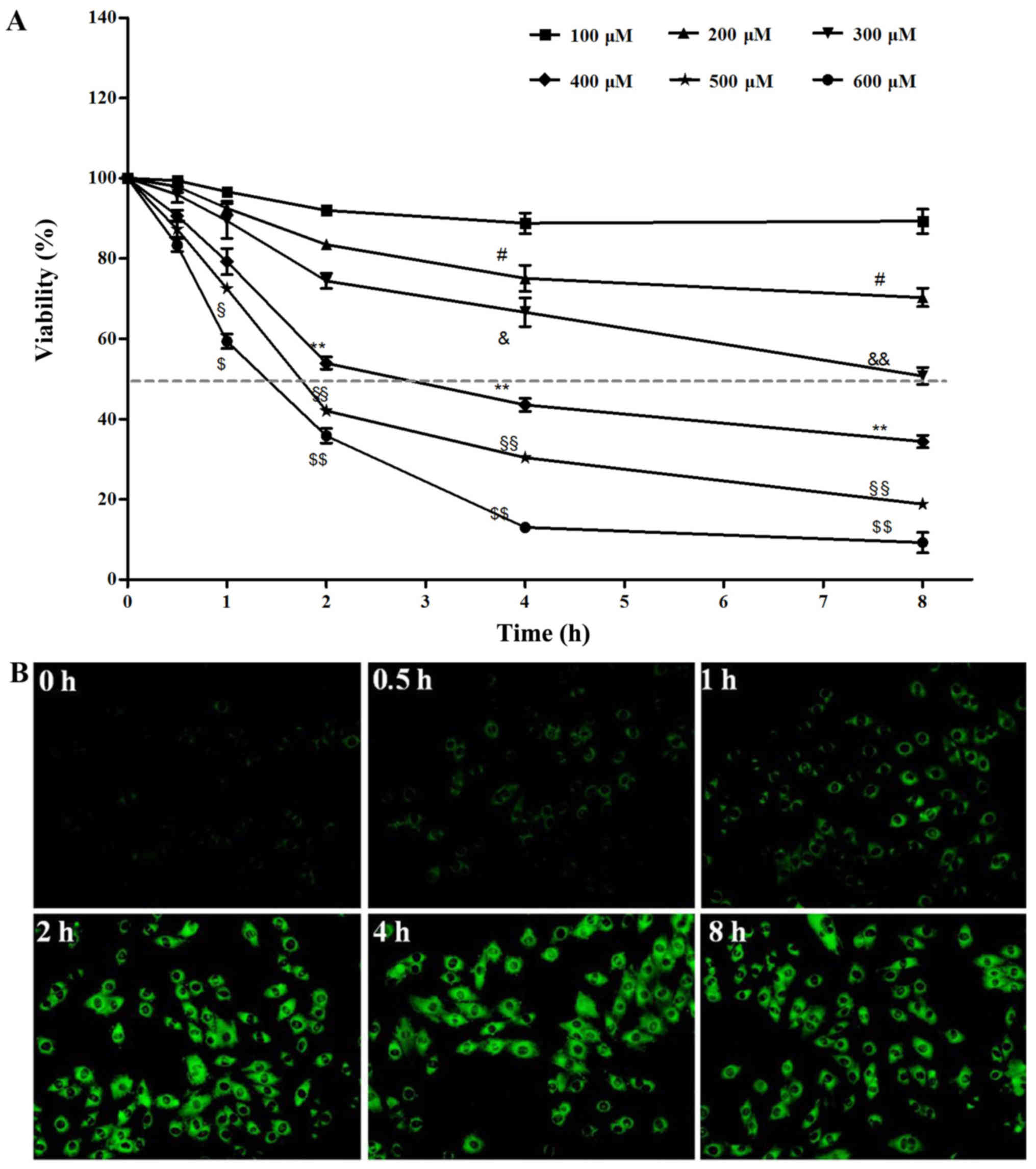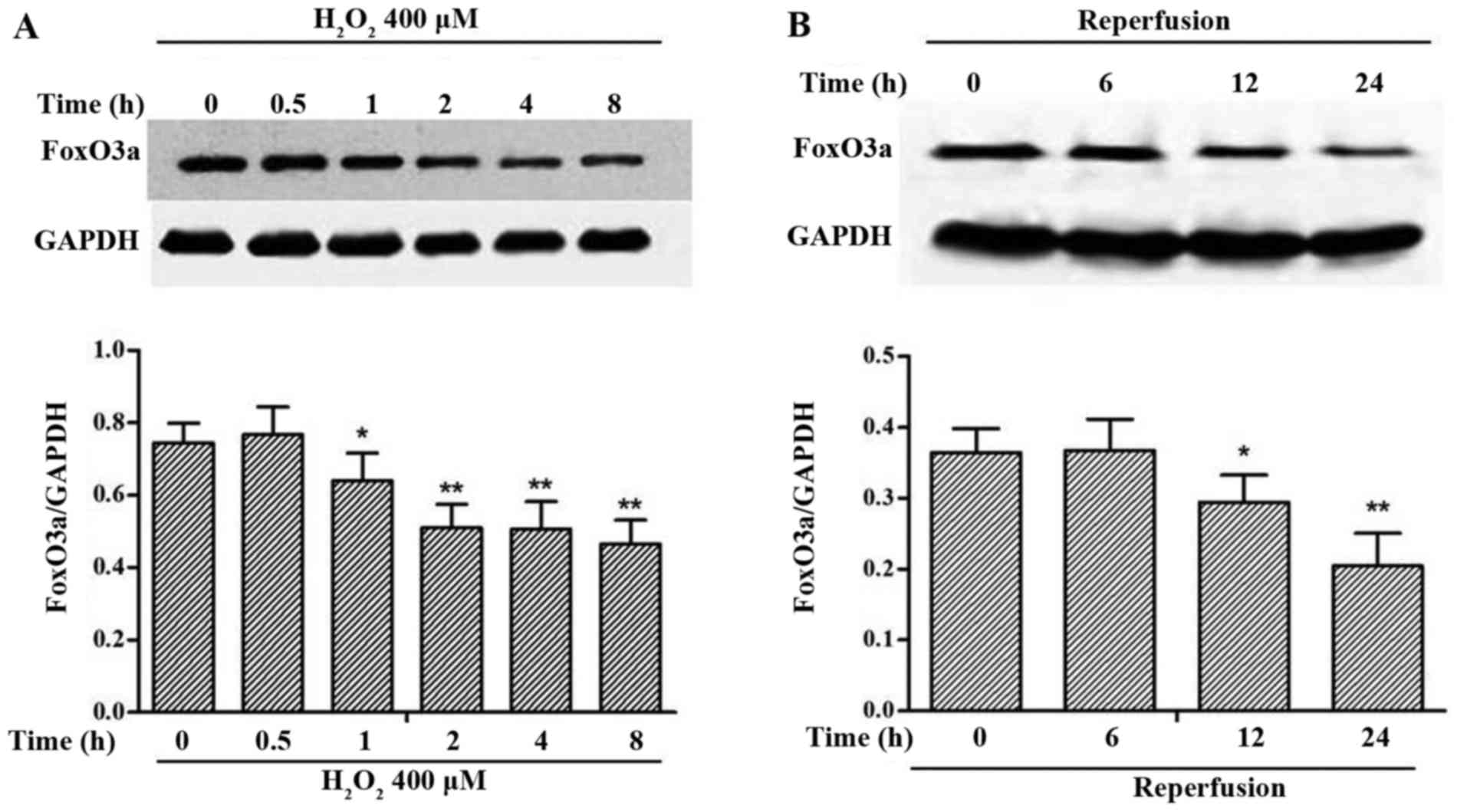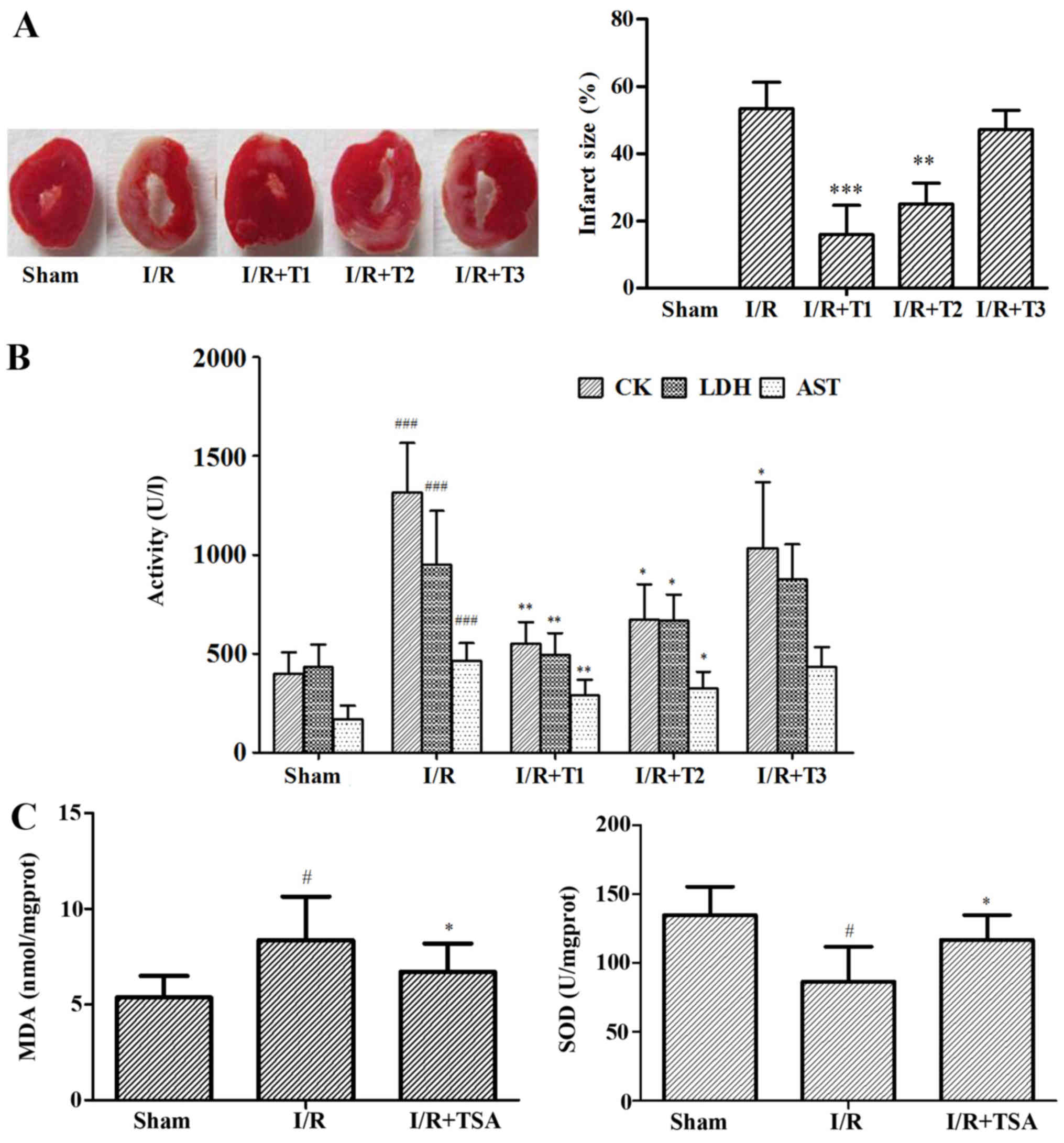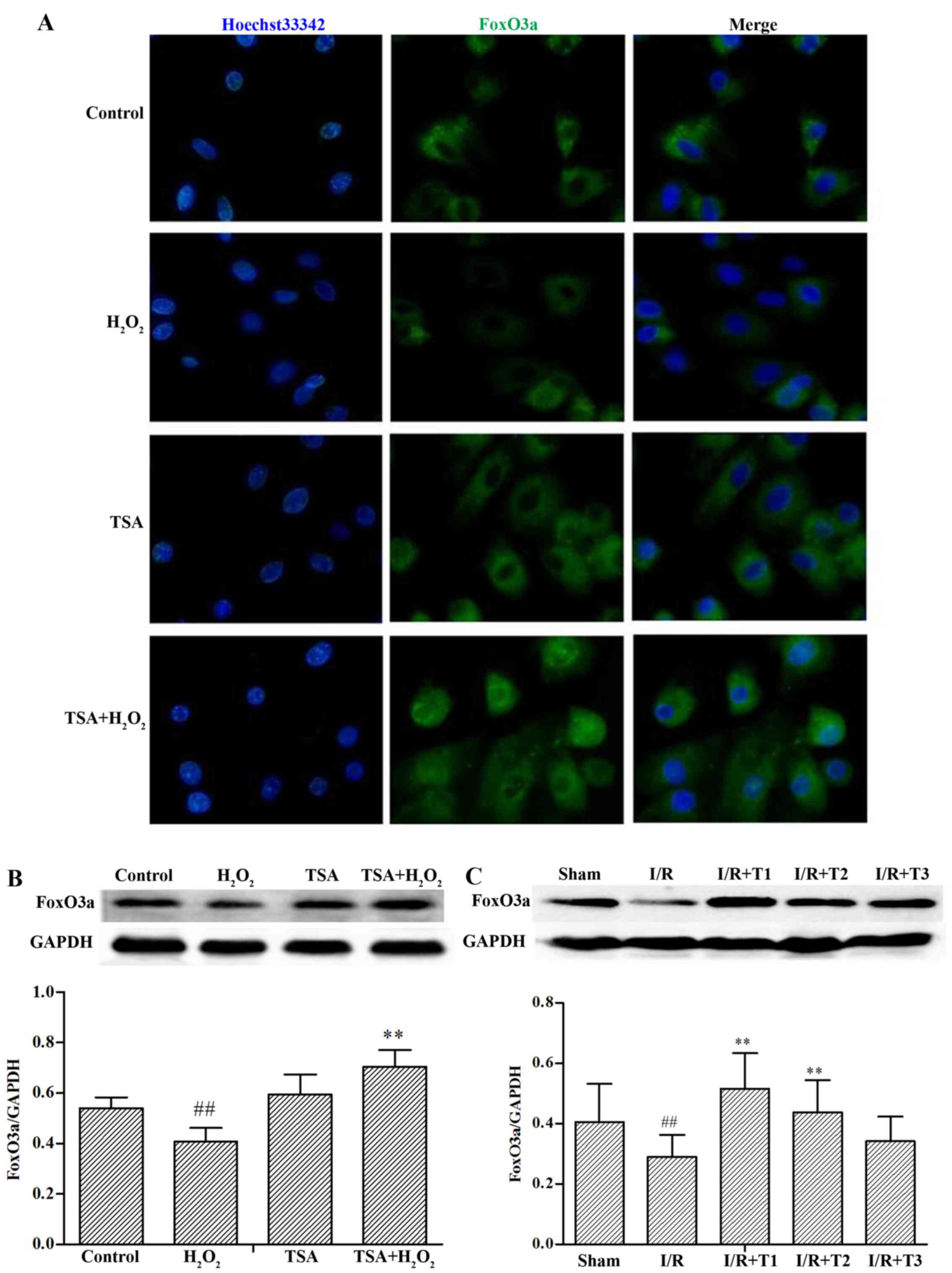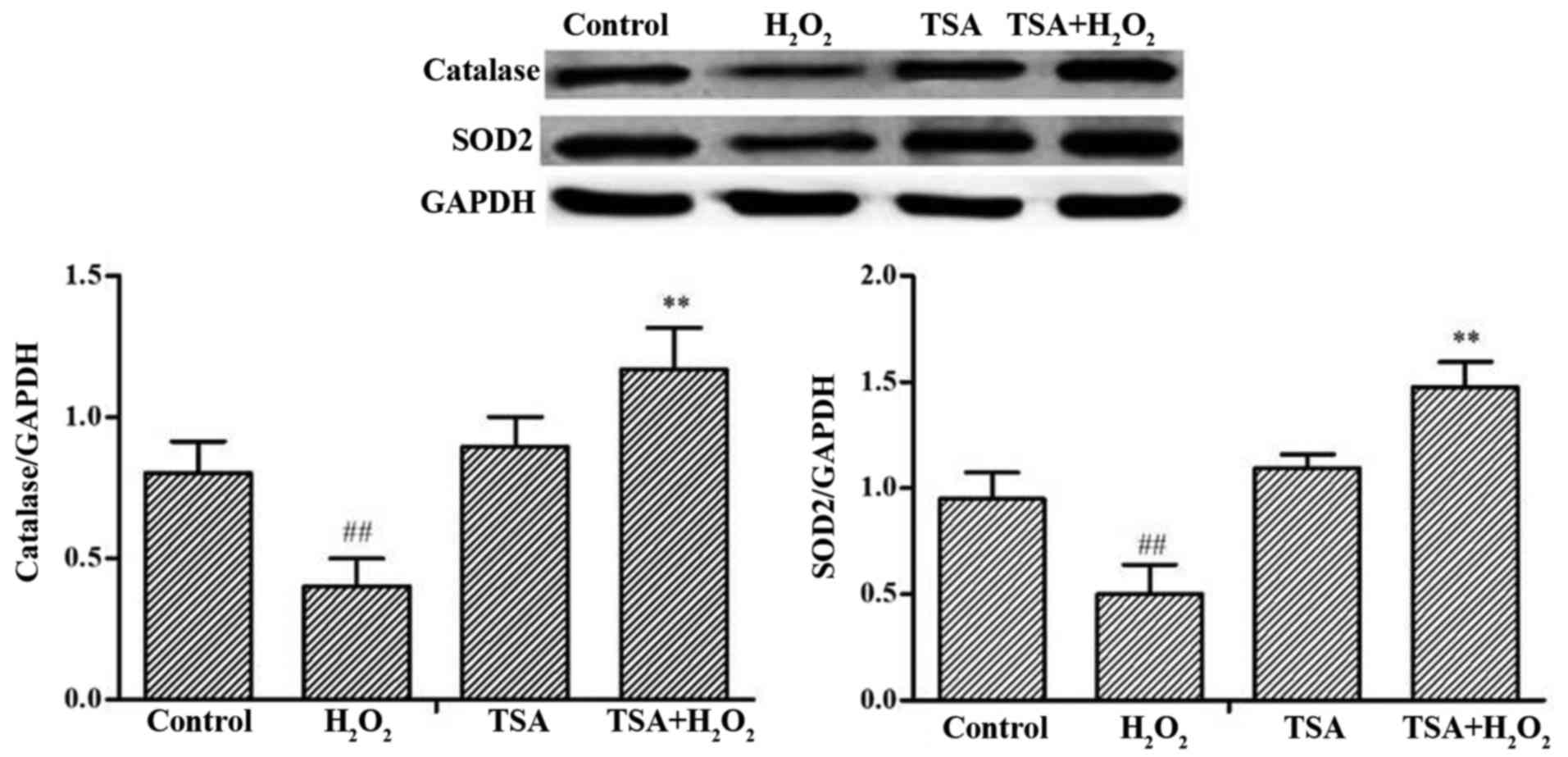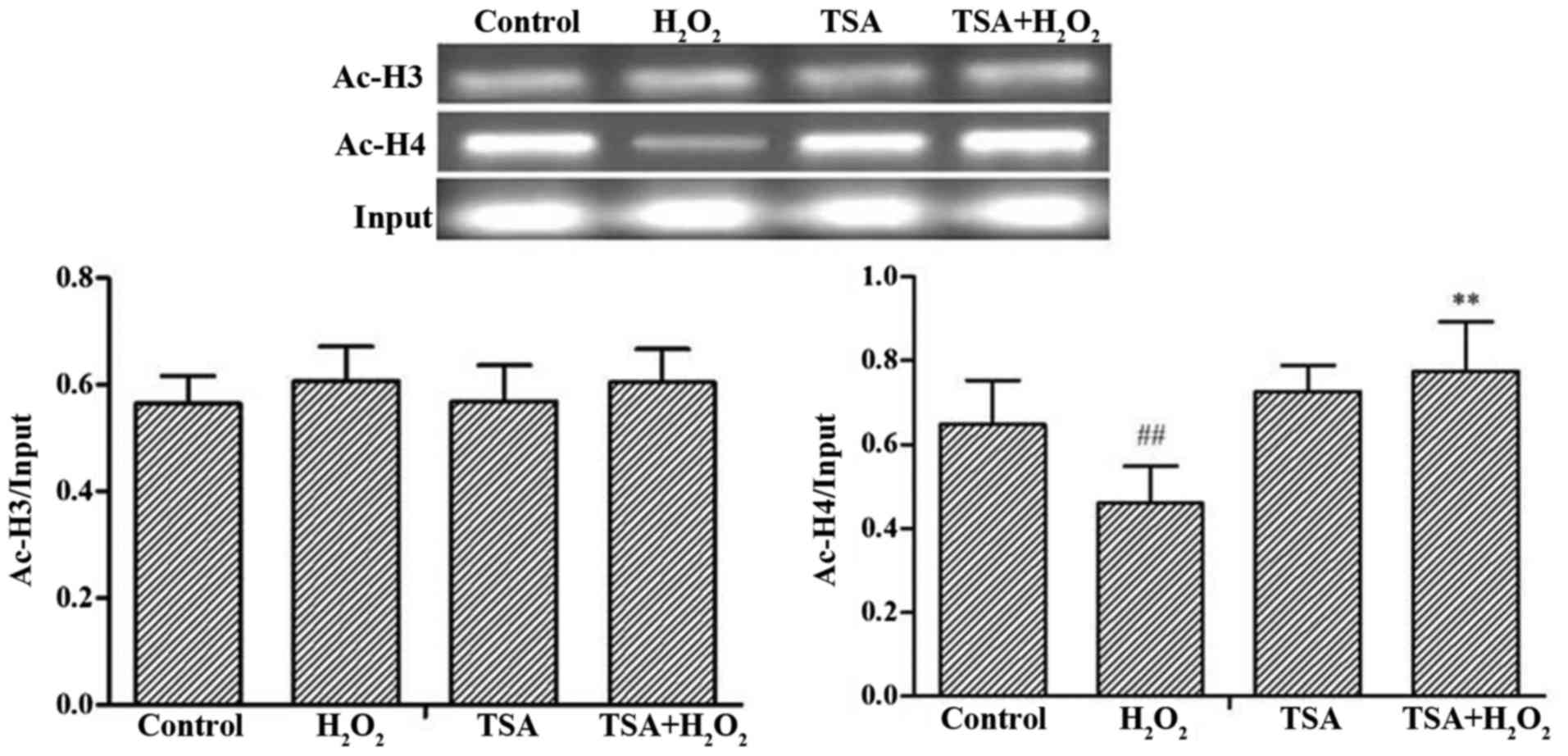|
1
|
Frank A, Bonney M, Bonney S, Weitzel L,
Koeppen M and Eckle T: Myocardial ischemia reperfusion injury: From
basic science to clinical bedside. Semin Cardiothorac Vasc Anesth.
16:123–132. 2012. View Article : Google Scholar : PubMed/NCBI
|
|
2
|
Cao J, Xie H, Sun Y, Zhu J, Ying M, Qiao
S, Shao Q, Wu H and Wang C: Sevoflurane post-conditioning reduces
rat myocardial ischemia reperfusion injury through an increase in
NOS and a decrease in phopshorylated NHE1 levels. Int J Mol Med.
36:1529–1537. 2015. View Article : Google Scholar : PubMed/NCBI
|
|
3
|
Jennings RB, Sommers HM, Smyth GA, Flack
HA and Linn H: Myocardial necrosis induced by temporary occlusion
of a coronary artery in the dog. Arch Pathol. 70:68–78.
1960.PubMed/NCBI
|
|
4
|
Matsumoto T, Miura T, Miki T, Nishino Y,
Nakamura Y and Shimamoto K: Does enhanced expression of the
Na+-Ca2+ exchanger increase myocardial
vulnerability to ischemia/reperfusion injury in rabbit hearts? Mol
Cell Biochem. 248:141–147. 2003. View Article : Google Scholar : PubMed/NCBI
|
|
5
|
Wang M, Baker L, Tsai BM, Meldrum KK and
Meldrum DR: Sex differences in the myocardial inflammatory response
to ischemia-reperfusion injury. Am J Physiol Endocrinol Metab.
288:E321–E326. 2005. View Article : Google Scholar
|
|
6
|
Qin C, Yap S and Woodman OL: Antioxidants
in the prevention of myocardial ischemia/reperfusion injury. Expert
Rev Clin Pharmacol. 2:673–695. 2009. View Article : Google Scholar : PubMed/NCBI
|
|
7
|
Sanada S, Komuro I and Kitakaze M:
Pathophysiology of myocardial reperfusion injury: Preconditioning,
postconditioning, and translational aspects of protective measures.
Am J Physiol Heart Circ Physiol. 301:H1723–H1741. 2011. View Article : Google Scholar : PubMed/NCBI
|
|
8
|
Guo J, Zheng D, Li HR, Zhang AD and Li ZC:
Anti-apoptotic potency of TNFR:Fc gene in
ischemia/reperfusion-induced myocardial cell injury. Inflammation.
38:664–671. 2015. View Article : Google Scholar
|
|
9
|
Zhou T, Chuang CC and Zuo L: Molecular
characterization of reactive oxygen species in myocardial
ischemia-reperfusion injury. BioMed Res Int. 2015:8649462015.
View Article : Google Scholar : PubMed/NCBI
|
|
10
|
Nho RS and Hergert P: FoxO3a and disease
progression. World J Biol Chem. 5:346–354. 2014. View Article : Google Scholar : PubMed/NCBI
|
|
11
|
Li M, Chiu JF, Mossman BT and Fukagawa NK:
Downregulation of manganese-superoxide dismutase through
phosphorylation of FOXO3a by Akt in explanted vascular smooth
muscle cells from old rats. J Biol Chem. 281:40429–40439. 2006.
View Article : Google Scholar : PubMed/NCBI
|
|
12
|
Dell'Aversana C, Lepore I and Altucci L:
HDAC modulation and cell death in the clinic. Exp Cell Res.
318:1229–1244. 2012. View Article : Google Scholar : PubMed/NCBI
|
|
13
|
Grunstein M: Histone acetylation in
chromatin structure and transcription. Nature. 389:349–352. 1997.
View Article : Google Scholar : PubMed/NCBI
|
|
14
|
Shats I, Gatza ML, Liu B, Angus SP, You L
and Nevins JR: FOXO transcription factors control E2F1
transcriptional specificity and apoptotic function. Cancer Res.
73:6056–6067. 2013. View Article : Google Scholar : PubMed/NCBI
|
|
15
|
Icardi L, De Bosscher K and Tavernier J:
The HAT/HDAC interplay: Multilevel control of STAT signaling.
Cytokine Growth Factor Rev. 23:283–291. 2012. View Article : Google Scholar : PubMed/NCBI
|
|
16
|
Cardinale JP, Sriramula S, Pariaut R,
Guggilam A, Mariappan N, Elks CM and Francis J: HDAC inhibition
attenuates inflammatory, hypertrophic, and hypertensive responses
in spontaneously hypertensive rats. Hypertension. 56:437–444. 2010.
View Article : Google Scholar : PubMed/NCBI
|
|
17
|
Usami M, Kishimoto K, Ohata A, Miyoshi M,
Aoyama M, Fueda Y and Kotani J: Butyrate and trichostatin A
attenuate nuclear factor kappaB activation and tumor necrosis
factor alpha secretion and increase prostaglandin E2 secretion in
human peripheral blood mononuclear cells. Nutr Res. 28:321–328.
2008. View Article : Google Scholar : PubMed/NCBI
|
|
18
|
Lu JC, Chang YT, Wang CT, Lin YC, Lin CK
and Wu ZS: Trichostatin A modulates thiazolidinedione-mediated
suppression of tumor necrosis factor α-induced lipolysis in 3T3-L1
adipocytes. PLoS One. 8:e715172013. View Article : Google Scholar
|
|
19
|
Yu L, Lu M, Wang P and Chen X:
Trichostatin A ameliorates myocardial ischemia/reperfusion injury
through inhibition of endoplasmic reticulum stress-induced
apoptosis. Arch Med Res. 43:190–196. 2012. View Article : Google Scholar : PubMed/NCBI
|
|
20
|
Sengupta A, Molkentin JD, Paik JH, DePinho
RA and Yutzey KE: FoxO transcription factors promote cardiomyocyte
survival upon induction of oxidative stress. J Biol Chem.
286:7468–7478. 2011. View Article : Google Scholar :
|
|
21
|
Shimazu T, Hirschey MD, Newman J, He W,
Shirakawa K, Le Moan N, Grueter CA, Lim H, Saunders LR, Stevens RD,
et al: Suppression of oxidative stress by β-hydroxybutyrate, an
endogenous histone deacetylase inhibitor. Science. 339:211–214.
2013. View Article : Google Scholar
|
|
22
|
Li H, Liu Z, Wang J, Wong GT, Cheung CW,
Zhang L, Chen C, Xia Z and Irwin MG: Susceptibility to myocardial
ischemia reperfusion injury at early stage of type 1 diabetes in
rats. Cardiovasc Diabetol. 12:1332013. View Article : Google Scholar : PubMed/NCBI
|
|
23
|
Bollini S, Cheung KK, Riegler J, Dong X,
Smart N, Ghionzoli M, Loukogeorgakis SP, Maghsoudlou P, Dubé KN,
Riley PR, et al: Amniotic fluid stem cells are cardioprotective
following acute myocardial infarction. Stem Cells Dev.
20:1985–1994. 2011. View Article : Google Scholar : PubMed/NCBI
|
|
24
|
Rukoyatkina N, Mindukshev I, Walter U and
Gambaryan S: Dual role of the p38 MAPK/cPLA2 pathway in the
regulation of platelet apoptosis induced by ABT-737 and strong
platelet agonists. Cell Death Dis. 4:e9312013. View Article : Google Scholar : PubMed/NCBI
|
|
25
|
Nechipurenko IV and Broihier HT: FoxO
limits microtubule stability and is itself negatively regulated by
microtubule disruption. J Cell Biol. 196:345–362. 2012. View Article : Google Scholar : PubMed/NCBI
|
|
26
|
Torres-Gonzalez M, Gawlowski T, Kocalis H,
Scott BT and Dillmann WH: Mitochondrial 8-oxoguanine glycosylase
decreases mitochondrial fragmentation and improves mitochondrial
function in H9C2 cells under oxidative stress conditions. Am J
Physiol Cell Physiol. 306:C221–C229. 2014. View Article : Google Scholar :
|
|
27
|
Akasaki Y, Alvarez-Garcia O, Saito M,
Caramés B, Iwamoto Y and Lotz MK: FoxO transcription factors
support oxidative stress resistance in human chondrocytes.
Arthritis Rheumatol. 66:3349–3358. 2014. View Article : Google Scholar : PubMed/NCBI
|
|
28
|
Huang W, Li G, Qiu J, Gonzalez P and
Challa P: Protective effects of resveratrol in experimental retinal
detachment. PLoS One. 8:e757352013. View Article : Google Scholar : PubMed/NCBI
|
|
29
|
Lijnen PJ, van Pelt JF and Fagard RH:
Downregulation of manganese superoxide dismutase by angiotensin II
in cardiac fibroblasts of rats: Association with oxidative stress
in myocardium. Am J Hypertens. 23:1128–1135. 2010. View Article : Google Scholar : PubMed/NCBI
|
|
30
|
Tan WQ, Wang K, Lv DY and Li PF: Foxo3a
inhibits cardiomyocyte hypertrophy through transactivating
catalase. J Biol Chem. 283:29730–29739. 2008. View Article : Google Scholar : PubMed/NCBI
|
|
31
|
Adluri RS, Thirunavukkarasu M, Zhan L,
Maulik N, Svennevig K, Bagchi M and Maulik G: Cardioprotective
efficacy of a novel antioxidant mix VitaePro against ex vivo
myocardial ischemia-reperfusion injury. Cell Biochem Biophys.
67:281–286. 2013. View Article : Google Scholar
|
|
32
|
Chen Q, Moghaddas S, Hoppel CL and
Lesnefsky EJ: Reversible blockade of electron transport during
ischemia protects mitochondria and decreases myocardial injury
following reperfusion. J Pharmacol Exp Ther. 319:1405–1412. 2006.
View Article : Google Scholar : PubMed/NCBI
|
|
33
|
Ji L, Fu F, Zhang L, Liu W, Cai X, Zhang
L, Zheng Q, Zhang H and Gao F: Insulin attenuates myocardial
ischemia/reperfusion injury via reducing oxidative/nitrative
stress. Am J Physiol Endocrinol Metab. 298:E871–E880. 2010.
View Article : Google Scholar : PubMed/NCBI
|
|
34
|
Salih DA and Brunet A: FoxO transcription
factors in the maintenance of cellular homeostasis during aging.
Curr Opin Cell Biol. 20:126–136. 2008. View Article : Google Scholar : PubMed/NCBI
|
|
35
|
Zeng Y, Cheng L, Chen H, Cao H, Hauser ER,
Liu Y, Xiao Z, Tan Q, Tian XL and Vaupel JW: Effects of FOXO
genotypes on longevity: A biodemographic analysis. J Gerontol A
Biol Sci Med Sci. 65:1285–1299. 2010. View Article : Google Scholar : PubMed/NCBI
|
|
36
|
Ronnebaum SM and Patterson C: The FoxO
family in cardiac function and dysfunction. Annu Rev Physiol.
72:81–94. 2010. View Article : Google Scholar : PubMed/NCBI
|
|
37
|
Kops GJ, Dansen TB, Polderman PE, Saarloos
I, Wirtz KW, Coffer PJ, Huang TT, Bos JL, Medema RH and Burgering
BM: Forkhead transcription factor FOXO3a protects quiescent cells
from oxidative stress. Nature. 419:316–321. 2002. View Article : Google Scholar : PubMed/NCBI
|
|
38
|
Paradies G, Petrosillo G, Paradies V and
Ruggiero FM: Mitochondrial dysfunction in brain aging: Role of
oxidative stress and cardiolipin. Neurochem Int. 58:447–457. 2011.
View Article : Google Scholar : PubMed/NCBI
|
|
39
|
Wang L, Lu K, Hao H, Li X, Wang J, Wang K,
Wang J, Yan Z, Zhang S, Du Y, et al: Decreased autophagy in rat
heart induced by anti-β1-adrenergic receptor autoantibodies
contributes to the decline in mitochondrial membrane potential.
PLoS One. 8:e812962013. View Article : Google Scholar
|
|
40
|
Peserico A and Simone C: Physical and
functional HAT/HDAC interplay regulates protein acetylation
balance. J Biomed Biotechnol. 2011:3718322011. View Article : Google Scholar
|
|
41
|
Chen H, Tini M and Evans RM: HATs on and
beyond chromatin. Curr Opin Cell Biol. 13:218–224. 2001. View Article : Google Scholar : PubMed/NCBI
|
|
42
|
Motta MC, Divecha N, Lemieux M, Kamel C,
Chen D, Gu W, Bultsma Y, McBurney M and Guarente L: Mammalian SIRT1
represses forkhead transcription factors. Cell. 116:551–563. 2004.
View Article : Google Scholar : PubMed/NCBI
|



